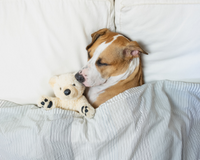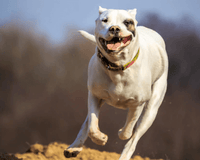Separation anxiety is such a challenging behavioural issue for both dogs and their humans. Dogs and humans are similar in that we are both social creatures who love to be around others.
Being left alone can cause us both to become anxious and nervous. Below we explore the signs and symptoms of separation anxiety, what you can do for a dog with separation anxiety, and most importantly, how to prevent dog separation anxiety.
What is separation anxiety in dogs?
Separation anxiety is when a dog gets overly attached to its owner and becomes extremely distressed when left alone. Separation anxiety is more than just a little whining when you go out the front door, or creating a little mess when you’re away.
It’s a severe condition and is a reason why dogs end up in rescue shelters.
What causes separation anxiety in dogs?There are a few different factors that can cause separation anxiety in dogs.
Firstly, it can be caused by being left alone for the first time when they have previously spent so much time with people. Your dog may develop separation anxiety when they leave a shelter and move to a new home or if they change owners.
The loss of a family member or a change in routine can trigger separation anxiety in your dog's brain. And unfortunately, some dogs are just genetically predisposed to have the condition.
What are signs of anxiety in dogs?Unfortunately, most of these signs and symptoms occur when the dog is left alone and away from the owner, making them tricky to spot. We recommend purchasing a quality pet camera so you can see exactly what your dog gets up to whilst you're away.
These behaviours are distressing; knowing your dog is in such an anxious state is worrying. This is why we want to explore what you can do about separation anxiety and how to prevent separation anxiety in dogs.
Pacing
When your dog is left alone, they may pace in a fixed pattern. Pacing can be moving in straight lines or moving in a circular shape; the key is that the movement pattern is fixed. If your dog paces and it’s caused by separation anxiety, it’s likely they won’t pace when you’re present.
Destruction
For some dogs, destruction, digging and chewing are their outlets for separation anxiety. They may dig at doors, chew on objects, window frames or door frames and may destroy household objects.
These behaviours are concerning as they can result in injury. Your dog may damage their nails, teeth or paws in the process. Again, if this behaviour is caused by separation anxiety, the dog isn’t likely to do it in your presence.
Howling and Barking
Dogs may howl or bark if they are alone and experiencing separation anxiety. Howling or barking for a dog with separation anxiety will be triggered by just being left alone and will be relentless.
Defecating or Urinating
Some dogs defecate or urinate when they’re left alone. If your dog does this in your presence, it’s likely that separation anxiety isn’t the cause.
Escaping
For some dogs, the feelings of separation anxiety are so unbearable that they try to escape. The dog could dig or chew through windows, walls and doors. This could also result in self-injury, on top of the physical damage to your home.
Eating Their Excrement
In their anxious state, some dogs may defecate and then consume their excrement. This isn’t a behaviour they will do in front of you if it’s caused by separation anxiety.
How to Prevent Separation Anxiety in Dogs
Here are our top tips for preventing separation anxiety in dogs.
1. Gradually Increase Alone Time
A simple approach to minimise separation anxiety in dogs is to build up their tolerance to alone time.
This means increasing the time your dog spends alone. Start with baby steps like partially closing a door, after that; you can move to closing the door, moving to another room and then leaving them alone outside.
If you find your dog gets stressed, do this training once a day to avoid overwhelming them. It may take a few weeks to see real progress, so be patient, your dog is learning a new way to behave and this can take time.
2. Don’t Make a Fuss
Avoid making a big fuss when you leave and when you arrive home. By being loud and talking differently and letting your dog become extremely excited, your dog will think they are big, scary occasions.
If possible, leave when your dog is silent and distracted. And when you return, give your dog treats and some relaxing cuddles once they have calmed down.
3. Make Sure Your Dog is Independent
Your dog should be happy to be independent; they should be okay wandering around the house by themselves.
Don’t let your dog follow you around all of the time, and don’t react if your dog tries to get your attention with toys. Overall, we want your dog to be relaxed when you’re home and not stuck to you like glue.
If your dog does decide to naturally seek out some alone time, praise them for it! Instead of using treats, praise them with words and some random cuddles. Some sneaky dogs will do the trick, or behave how you want them to just to get a treat and not because they want to do that behaviour. Avoid this by using your love and kind words to praise them randomly.
4. Do Some Crate Training
Dogs love to retreat in safe dens; teaching them that a crate is a safe place will protect your house and keep them calm.
Crate training has to be a positive experience only; the crate is your dog's heavenly private space. Fill it with their favourite toys and a snuggly bed.
To make crate training positive, keep the door open for the first few times. And feed them treats when they’re in the crate to reward them; you can feed them their breakfast or dinner in the crate too.
Your dog should use the crate when they’re left home alone or when you’re there. The crate needs to be associated with being their personal space, not a place they’re left when you’re away.
5. Keep Them Challenged
Mental stimulation is vital for dogs. Purchase different dog puzzles and enrichment toys to keep them occupied when you’re gone.
Ideally, tire them out each day with a walk, run or session of playing with other dogs. These activities will keep their energy in check, and hopefully, avoid long sessions of destructive behaviour.
When walking, take a different route so your dog can experience new sights and smells all the time. Get involved with dog sports like agility or flyball, let them play off-leash or play lots of fun games together like tug of war.

How Do You Stop Separation Anxiety in Dogs?
If your dog already has separation anxiety, the best place to start is talking to your vet.
They may be able to offer some tailored advice and may even prescribe medication to reduce your dog's overall anxiety.
With a diagnosis from your vet, you’ll know where to start with the anxiety preventing tips above.
You can stop separation anxiety in dogs with the tips above, but remember it’ll take a lot of time and patience to see improvements. No dog with anxiety can turn it off instantly, be patient and consistent with your training together.
Can a Dog Outgrow Separation Anxiety?
Typically, dog separation doesn’t go away on its own, nor can it be grown out of.
If left unchecked, your dog’s anxiety will continue to increase.
And once you do find a way to manage your dog’s anxiety, your dog won’t be cured forever. You’ll need to continue your dog training efforts to ensure your dog doesn’t regress.
What Won’t Help a Dog With Separation Anxiety
Punishment won’t help a dog with separation anxiety. Your dog won’t understand why they’re being punished when they’re in an anxious state. They will associate the punishment with another action or behaviour, which will confuse them and potentially make the situation worse.
Adding another dog won’t help your dog to deal with their separation anxiety. Your dog’s separation anxiety is tied to being away from you, not because they are lonely.
Preventing Separation Anxiety in Dogs
It’s much easier to prevent separation anxiety by making the tips outlined above a daily part of your life.
Curing your dog of anxiety is a much more complex issue. But it can be done; with your love, patience and consistency, you can improve your dog’s anxiety.
Use the tips above, talk to your vet, and work together with your dog to rid them of their stress.
And check out our range of dog anxiety products, available at eDog
If you have any questions about which of our products may be helpful for your dog, contact our customer service team. We love dogs and strive to make sure we find the best product to suit your dog perfectly. Call now!









